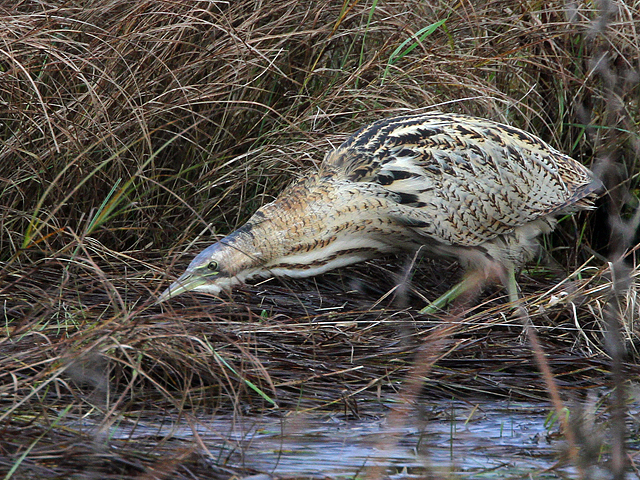Bittern, Botaurus stellaris
Local status: Scarce winter visitor, with breeding territories established in the late 1990s.
Formerly a very rare winter visitor, Bittern fortunes in the UK have improved since concerted conservation efforts began in the 1990s. The increasing UK population which has included the return of Bitterns as a breeding species in Yorkshire has caused an upsurge in records in the York area and birds have established breeding territories in at least four years in the mid to late 1990s. Subsequently, despite continued growth of the population in the UK, no further breeding attempts have occurred and the species has become a rare winter visitor. This is presumably the result of a lack of suitable breeding habitat for Bitterns in the York area.

Records:
2023: Bank Island, 28th December. one
2023: Gascoigne Wood, 27th & 28th May. one booming
2022: Pocklington Canal at Hagg Bridge, 18th August & 8th September. one
2022: East Cottingwith/Storwood area of Pocklington Canal, late January/early
February. one
2022: Aughton Ings, 11th January. one
2021: Pocklington Canal near Melbourne, 19th July. one
2021: Wheldrake Ings, 13th April. one booming at dusk
2020: North Duffield Carrs, 31st July. one
2019: South Milford, 6th November, one west
2018: East Cottingwith Ings, 2nd to 6th April. one booming
2018: Wheldrake Ings, 14th February. one
2017: Pocklington Canal at Church Bridge, 21st December. one
2016: Wheldrake Ings, 23rd September. one
2015: Bank Island, 22nd April.
2014: Bielby, 20th December.
2014: Wheldrake Ings, 3rd and 4th December.
2014: North Duffield Carrs, 22nd March.
2012: North Duffield Carrs, 15th to 22nd November
2012: Wheldrake Ings, 8th February
2010: Bilbrough, 28th February.
2009: Skipwith Common, 3rd March.
2007: North Duffield Carrs, 29th October.
2007: North Duffield Carrs, 19th August and Wheldrake Ings, 24th August.
2006: North Duffield Carrs, 2nd June.
2003: Allerthorpe GP, 16th November.
2003: Allerthorpe GP, 18th January.
2001: Lower Derwent Valley, 15th January to 7th February.
1999: Lower Derwent Valley, 23rd April to 27th May.
1998: Wheldrake Ings then Melbourne, 14th March to 23rd June.
1997: Wheldrake Ings, 14th October. One, with two in November.
1997: Lower Derwent Valley, 9th February to 21st March. Two.
1996: Lower Derwent Valley, breeding season.
1995: Wheldrake Ings, 3rd to 31st December. Joined by a second bird on 15th.
1995: Lower Derwent Valley, breeding season.
1994: Wheldrake Ings, 11th and 26th December.
1994: Wheldrake Ings, 7th to 12th May. Booming male.
1993: Lower Derwent Valley, sporadically between 13th January and 7th May.
1989: Bielby Beck, 26th December.
1984: Lower Derwent Valley, 2nd March. Picked up dead.
1983: Strensall Common, 26th December.
1983: Aughton, 4th November, Storwood, 11th December, Wheldrake Ings, 19th December probably all relate to one bird.
1983: Wheldrake Ings, 2nd February.
1982: Wheldrake Ings, 14th November.
1982: Askham Bog, 15th February.
1981: Wheldrake village, 12th December
1978: Newton-on-Derwent, 30th December.
1974: Lower Derwent Valley, 2nd to 10th March.
